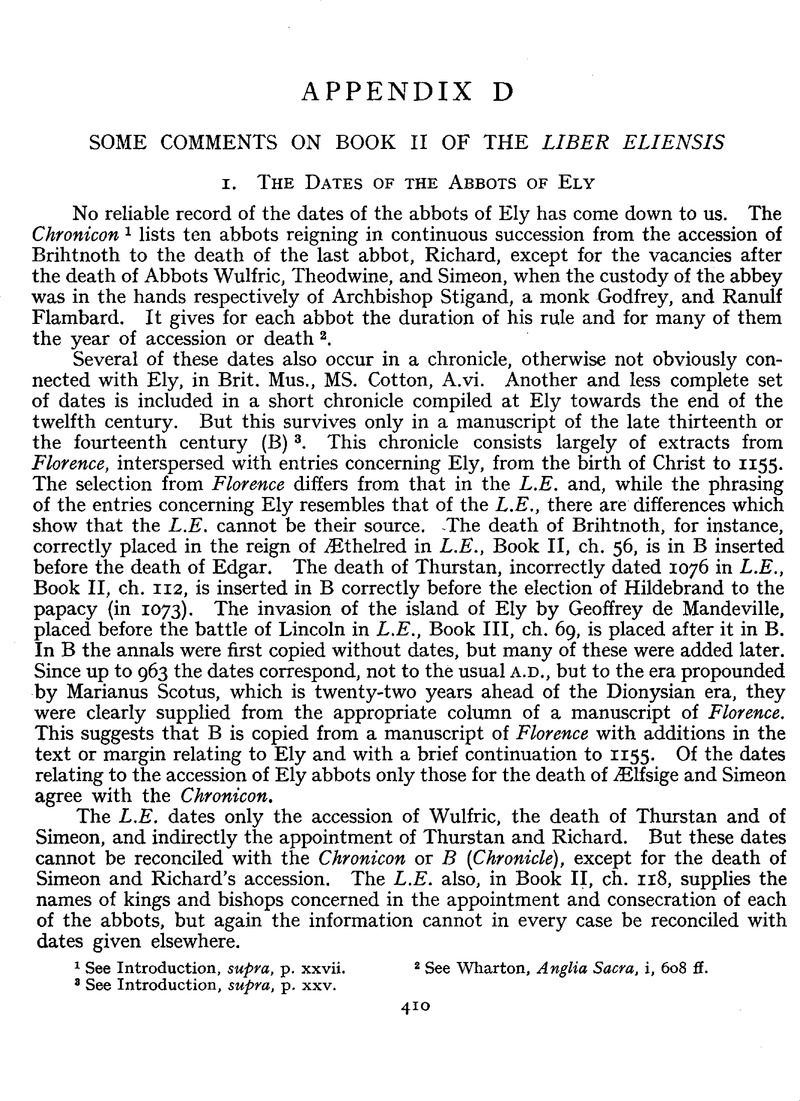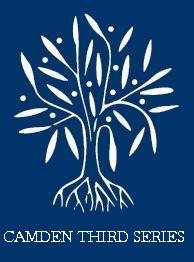No CrossRef data available.
Article contents
Appendix D: Some Comments on Book II of the Liber Eliensis
Published online by Cambridge University Press: 24 December 2009
Abstract

- Type
- Appendices
- Information
- Copyright
- Copyright © Royal Historical Society 1962
References
page 410 note 1 See Introduction, supra, p. xxvii.
page 410 note 2 See Wharton, Anglia Sacra, i, 608 ff.
page 410 note 3 See Introduction, supra, p. xxv.
page 411 note 1 Robertson, Charters, p. 130.
page 411 note 2 Cf. Liber Monasterii de Hyda (R.S.), pp. 242–53. It is dated 996 in Whitelock, English Historical Documents c. 500–1042, no. 120, pp. 531–34.
page 411 note 3 Cf. Robertson, Charters, p. 374.
page 411 note 4 Whitelock, op. cit., no. 127, p. 545.
page 411 note 5 For the suggestion that Ælfwine succeeded Ælfgar as bishop of Elmham in 1016 see supra, Book II, ch. 75.
page 411 note 6 See The Peterborough Chronicle, ed. D. Whitelock, p. 30.
page 412 note 1 B (Chronicle) seems to have confused the names Leofwine, Leofric, and Leofsige. Ælfsige is succeeded by Leofric, who dies in 1021 and is followed by Leofwine. Next comes the appointment of Wulfric, but he is made to take over on the death of Leofric, which must be a mistake for Leofsige. It is pointless to speculate on the basis of the evident inaccuracies of B (Chronicle) except that it may be worth noting that, if Leofric were given a seven years' rule to 1021, he would have succeeded during Æthelred's reign. In this case the grant recorded in Cnut's charter of 1022 could have been made before Leofric's death and when the grant was confirmed by charter the Abbot Leofwine who is among its signatories could be the recently appointed abbot of Ely.
page 412 note 2 Harmer, Writs, no. 62.
page 412 note 3 Robertson, Charters, p. 467.
page 412 note 4 Harmer, Writs, pp. 254–56 and 566; but cf. Robertson, Charters, p. 467.
page 412 note 5 See infra, App. D, p. 425.
page 412 note 6 Davis, Regesta, i, 17, no. 64.
page 412 note 7 See infra, p. 430.
page 412 note 8 Cf. Bentham, Ely, i, 105.
page 412 note 9 Wilkins, Concilia, i, 363–64.
page 413 note 1 Cf. Bentham, Ely, i, 105.
page 413 note 2 Annales Monastici, ii, 33.
page 413 note 3 Eadmer, Hist. Novorum, p. 142.
page 413 note 4 Ibid., pp. 178–79.
page 413 note 5 Diceto, i, 234.
page 413 note 6 Eadmer, Hist. Novorum, p. 185.
page 413 note 7 Florence, s.a. 1107.
page 413 note 8 For these dates see Bentham, Ely, i, 79–118; Freeman, Norman Conquest, iv, 824–25; Miller, Ely Land Pleas, p. 440.
page 414 note 1 On their comparative dates see D. J. V. Fisher, Engl. Hist. Rev., lxvii, 389–91, contested by D. Whitelock, English Historical Documents c. 300–1042, p. 831 f.
page 415 note 1 For the organisation of berewicks with special reference to this estate see Stenton, F. M., Types of Manorial Structure in the Northern Danelaw (1910), p. 83Google Scholar.
page 416 note 1 Finberg, H. P. R., The Early Charters of the West Midlands (1961), pp. 115–16Google Scholar, no. 301.
page 416 note 2 Bisantune, Dd, i, fo. 173.
page 417 note 1 The place-names are, where possible, identified in Essex Place-names, p. 530, n. 1 (q.v.). See also Hart, Essex Charters, nos. 36 and 41, pp. 21, 22 and cf. Æthelred's charter of 1008 (Book II, ch. 77).
page 417 note 2 See the brief comment in the footnotes to this chapter.
page 417 note 3 Writs, p. 222, n. 2.
page 418 note 1 Hart, Essex Charters, no. 56, p. 27.
page 418 note 2 See Dd, i, fo. 190b; I.E., pp. 185, 137–38, 136; I.C.C., p. 194 (the plea of 1071 × 1075); I.E., pp. 189, 129, 125.
page 418 note 3 See supra, App. C, p. 402.
page 418 note 4 See Harmer, Writs, pp. 222–24. For what may be a reference to the original document see Book II, cc. 96 and 97.
page 418 note 5 Cf. the note to ch. 92, supra.
page 419 note 1 Harmer, Writs, p. 224.
page 419 note 2 See Book II, ch. 117.
page 419 note 3 Harmer, Writs, p. 224.
page 419 note 4 Ely, pp. 26–35 and in V.C.H., Cambs., iv, 1–8.
page 419 note 5 Engl. Hist. Rev., lxiv, 292 ff.
page 419 note 6 Ramsey Chron., p. 54.
page 419 note 7 Dd, i, fos. 204b, 207, 208.
page 419 note 8 Ramsey Chron., p. 151.
page 419 note 9 Ramsey Cart., i, 270; iii, 167.
page 419 note 10 Ramsey Chron., p. 54.
page 419 note 11 See supra, Book II, ch. 48.
page 420 note 1 Ramsey Chron., pp. 62–63.
page 420 note 2 Ramsey Cart., i, 270; iii, 166.
page 420 note 3 Dd, i, fo. 204.
page 420 note 4 The date given in Knowles, D. and Hadcock, R. N., Medieval Religious Houses in England and Wales (1953), p. 76Google Scholar.
page 420 note 5 Robertson, Charters, p. 367.
page 420 note 6 Ord. Vit., Hist. Eccl., ii, 74. Cf. V.C.H., Hunts., i, 385; ii, 273; Dd, i, fos. 197b, 205b; Monasticon, ii, 95.
page 421 note 1 Dd, i, fo. 191.
page 422 note 1 H. M. Cam, Liberties and Communities, p. 101.
page 422 note 2 Dd, ii, fo. 384, Sudburnham.
page 422 note 3 Dd, ii, fo. 388b.
page 422 note 4 Ramsey Chron., pp. 116–17.
page 422 note 5 C. E. Wright, The Cultivation of Saga in Anglo-Saxon England, pp. 241–42.
page 422 note 6 P. 116.
page 422 note 7 Dd, i, fo. 204.
page 422 note 8 Ibid.
page 422 note 9 Dd, i, fo. 196.
page 422 note 10 Dd, i, fo. 191.
page 422 note 11 Ibid.
page 422 note 12 Dd, i, fo. 191b.
page 422 note 13 Dd, i, fo. 191.
page 422 note 14 Dd, i, fo. 19.
page 422 note 15 Dd, i, fo. 191b.
page 422 note 16 Dd, ii, fo. 410b.
page 422 note 17 Dd, ii, fo. 382b.
page 422 note 18 Dd, ii, fo. 136.
page 422 note 19 Dd, i, fo. 190b.
page 422 note 20 Dd, ii, fo. 191.
page 422 note 21 Whitelock, Wills, no. xv, pp. 40, 144. Cf. Hart, Essex Charters, no. 34, p. 20.
page 422 note 22 Whitelock, Wills, no. xv, p. 40.
page 422 note 23 Ibid., no. xiv, p. 34.
page 423 note 1 Cf. ibid., pp. 189–90.
page 423 note 2 Ibid., no. xiv, pp. 34–36, 138–39.
page 423 note 3 Dd, i, fo. 133b.
page 423 note 4 As suggested by Whitelock, Wills, p. 140. See Dd, i, fo. 135, for Ely holding 4 hides there.
page 423 note 5 Dd, i, fo. 135.
page 423 note 6 See Whitelock, Wills, p. 142.
page 423 note 7 Dd, i, fo. 191b.
page 423 note 8 This is not included in Edward the Confessor's charter of confirmation (ch. 92) and was held by Earl Harold in 1066 (Dd, i, fo. 202).
page 423 note 9 See supra, Book II, cc. 19 and 34.
page 423 note 10 Dd, i, fo. 190b.
page 423 note 11 Whitelock, Wills, no. xxxi, p. 80; also pp. 189–90. Ely held 4 carucates at Wetheringsett in 1066 (Dd, ii, fo. 384b).
page 423 note 12 Dd, ii, fo. 25.
page 423 note 13 Dd, i, fo. 196.
page 423 note 14 Dd, i, fo. 192b.
page 423 note 15 Whitelock, Wills, p. 141.
page 423 note 16 Unless the traditional date for the death of Abbot Leofsige is accepted, in which case the will cannot be later than 1044. See Ibid., p. 192; also pp. 189, 192–97. Cf. Hart, Essex Charters, no. 48, p. 24 and Ramsey Chron., pp. 59–60.
page 424 note 1 Dd, ii, fo. 382.
page 424 note 2 Ibid.
page 424 note 3 Dd, ii, fos. 382b–83.
page 424 note 4 Dd, ii, fo. 213b.
page 424 note 5 Dd, i, fo. 191.
page 424 note 6 Dd, i, fo. 199.
page 424 note 7 Ibid.
page 424 note 8 Miller, Ely, p. 66.
page 424 note 9 Cf. Liebermann, Gesetze der Angelsachsen, s.v. eorl, 7. The matter is discussed by W. Stubbs, Constitutional History of England (1873), i, 674, esp. notes 3 and 4, with particular reference to this chapter, and he draws attention inter alia to supra, Book II, ch. 7, where 40 hides are mentioned as the patrimony of an ealdorman.
page 424 note 10 Dd, ii, fos. 52b–54; V.C.H., Essex, i, 346.
page 424 note 11 Dd, ii, fos. 408–08b; V.C.H., Suffolk, i, 399.
page 424 note 12 Dd, ii, fo. 403b, 408b–09.
page 424 note 13 Dd, ii, fo. 406.
page 424 note 14 V.C.H., Essex, i, 390; Benstead in Sandon, Hart, Essex Charters, i, 29; Dd, ii, fo. 54.
page 424 note 15 Dd, ii, fos. 238–39; I.E., p. 140.
page 425 note 1 Dd, ii, fo. 212b. Cf. Miller, Ely, p. 25; Hart, op. cit., p. 29.
page 425 note 2 For a short note on his career and references to sources see Harmer, Writs, pp. 572–73.
page 425 note 3 Hamilton, I.C.C., pp. 101, 137–38.
page 425 note 4 Dd, i, fos. 38, 40b, 41b.
page 425 note 5 V.C.H., Herts., i, 275, 315.
page 425 note 6 V.C.H., Somerset, ii, 85.
page 425 note 7 Knowles, Monastic Order, p. 103.
page 425 note 8 Gesta Pontificum, p. 36.
page 425 note 9 Norman Conquest, iv, 468, 810.
page 425 note 10 Florence, ii, 1; William of Poitiers, Gesta Guillelmi, p. 244.
page 425 note 11 See supra, Book II, ch. 102.
page 425 note 12 Florence, ii, 5.
page 426 note 1 Gesta Pontificum, p. 37.
page 426 note 2 Annales Monastici, ii, 29.
page 426 note 3 Stenton, Anglo-Saxon England, p. 652, n. 6.
page 426 note 4 See supra, Book II, ch. 119, notes.
page 426 note 5 Feudal England, pp. 133–34, 459–61.
page 426 note 6 Ely Land Pleas, passim.
page 426 note 7 Op. cit., pp. 459–61; cf. Miller, op. cit., p. 441.
page 426 note 8 Cf. ibid., pp. 443–44.
page 427 note 1 See Ramsey Cart., i, 149.
page 427 note 2 See supra, Book II, ch. 117, notes, and Miller, op. cit., p. 444.
page 427 note 3 See Le Patourel, J. H., ‘ Geoffrey of Montbray, Bishop of Coutances, 1049–93 ’, Engl. Hist. Rev., lix (1944), pp. 159–61CrossRefGoogle Scholar, and Miller, op. cit., p. 444.
page 428 note 1 Op. cit., pp. 133–34.
page 428 note 2 Op. cit., pp. 445–50.
page 428 note 3 Ibid., where the evidence for what follows is assembled.
page 429 note 1 op. cit., p. 450.
page 430 note 1 See supra, Book II, ch. 134.
page 431 note 1 Printed by Hamilton, I.C.C., pp. 121–24, 174–83, 184–89, and described by Round, op. cit., p. 129 and Miller, op. cit., p. 453.
page 431 note 2 I.e. (i) the writs addressed to Lanfranc, Geoffrey of Coutances and Robert of Mortain (cc. 120 and 117 in 1081, followed by cc. 123 and 121 soon after Simeon's accession and by cc. 126 and 124 before the early summer of 1082); (ii) ch. 127, later in 1082, followed at an unspecified date by cc. 125 and 122.
page 432 note 1 But cf. Miller's sequence: cc. 126, 124, 127.


